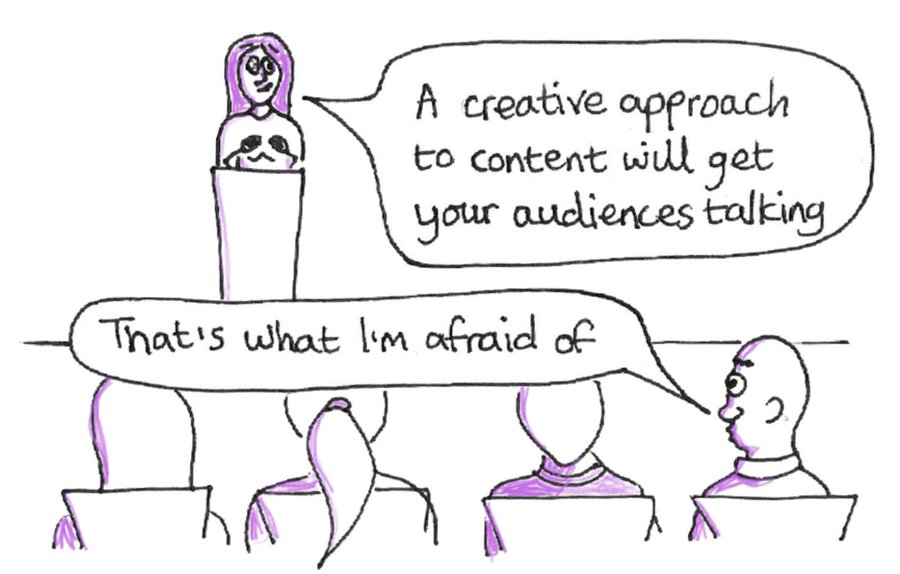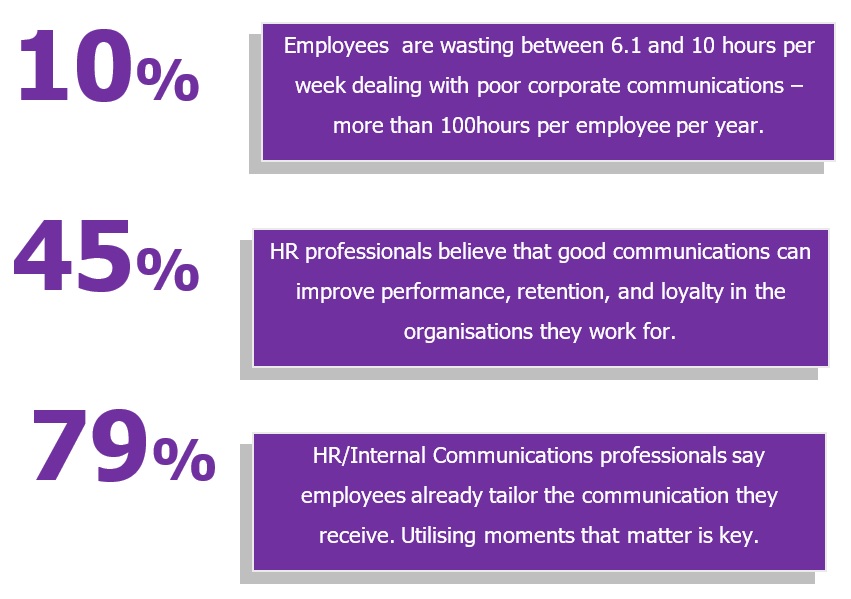Creativity in internal communications
Worth the fuss?
About the author
Eduvie Martin prepared this article as part of a CIPR Professional PR Diploma assignment while studying with PR Academy.


Employees do not read their emails so, let’s make them.
Let’s add in some vibrant designs, an upbeat tune and maybe some dance videos too; let’s have CEOs and their entire leadership team communicating key messages with rhymes and if we can get these leaders to break into song and dance while they are at it, even better – employees will be engaged.
Let’s make internal communications, innovative, interesting, and creative – these are the thoughts of the 21st-century internal communicator.
Internal communicators have evolved into executive producers, video editors, scriptwriters, storytellers, newscasters, and internal podcast hosts to capture the attention of employees and influence engagement levels.
Let’s pause for a minute to uncover the value of these unconventional and innovative tactics and channels used to communicate company objectives to employees.
Do we really need to invest in the resources and productive hours spent on creative content or are employees just craving a simple, short email with clear and concise updates, properly targeted, sent using the right channels, and at the right time?
Do employees need creativity in internal communications to keep them engaged and informed about the company’s purpose?
Let’s unpack it all, first beginning with the myth – Employees do not read their emails: “It is incorrect to assume that employees are not interested in an organisation’s strategy or plans”[i]. A recent survey among internal communicators revealed that email is still the preferred channel of communication. When thinking about creative content for an internal audience, it is easy to fixate on the communication channel with a viewpoint that slowly descends into an age-old rivalry of email versus intranet, video versus live broadcast. Shannon and Weaver encourage a reflection on not just the communication channel but the source, message, and destination – if we want to produce effective communication.
And Effective communication is creative communication says Massimo Franceschetti, a professor at Bologna Business School and an expert in effective communication. Franceschetti encourages a look at awareness, responsibility, respect, trust, and creativity for the development of effective communication.
Time for some reflection
Understanding organisational objectives is an essential part of building a sense of belonging which in turn impacts business performance. Some look to creativity in internal communications to create that sense of belonging. And, In comes – employee engagement.
Employee engagement has become a catch-all term for all tactics used to drive employees to embody company purpose and values. Some see it as “employees feeling a strong emotional bond to their employer, recommending it to others and committing time and effort to help the organisation succeed”[ii] while others see it as a psychological state experienced by employees. The Gallup theory[iii] on employee engagement revealed a dire look into how employees perceive employee engagement while the 2023 Edelman’s Trust Barometer revealed that 62% of the thirty-two thousand respondents from over twenty-eight countries who took their survey, trust their organisation.
Where there’s trust, message is received; but what happens to the other 38% who do not trust their organisation? Will presenting the message in fresh and unusual ways get the message across?
To answer these questions, organisations need to take a long hard look in the mirror.
Nadler’s Congruence Theory encourages a look at work, people, culture, and structure to see if they are in sync. Without these brilliant basics in place, nothing works. Field[iv] reflects on fairness as a key element for communication. She states that employees react to unfairness on themselves and others as they would, to physical pain. When unfairness is perceived, the recipient can be hindered from receiving the message.
Amy Edmondson, a leading expert in psychological safety defines psychological safety as the belief that one will not be punished or humiliated for speaking up with ideas, questions, concerns, or mistakes. In the article, Greenhous[v] says “psychological safety was often the missing element in organisations struggling to get internal communications right”.
Organisations enter their internal communications campaigns into award categories to influence positive brand sentiment from an internal and external audience, but this can also be another moment in time to stop and stare at the outcomes of the campaigns developed over the year in review. A moment to reflect on if you like what you see.
Let’s try listening
As communications professionals, we must hold ourselves accountable and question if we are delivering creative communications plans that contain clearly defined objectives.
To do this, we must understand our audience. Ruck[vi] writes about the evolution of international communications reminding us of when internal communicators were that group that listened to the employees and communicated their desires to the employers almost like a union would. It is quite fascinating to see how this has tipped on its head with internal communicators now focused largely on what the employer wants. Ruck, Pounsford, and Krais’ study on listening tell us we must listen with an open mind through thorough planning and at all levels of the organisation. This sounds like the common-sense thing to do but we all miss it, get caught up on the deliverables, and forget to do this. Williams tells us: “Listening is about understanding how the people who operate within and with organisations think and feel to make their relationships and transactions more effective”
The 2023 Firstup Message in the moment[vii] survey of employees in the US and some parts of Europe revealed some useful insights:

Listening gives us insights into what employers and employees want. To give stakeholders what they need, not what they want, we must set clear objectives.
Measuring what matters
“Measurement replaces intuition, which is often fallible. It replaces trust, which is often misplaced. It finesses complexity, which is frequently irreducible[viii]”. This survey shows that 61% of Internal Communicators are spending their time writing content, 8% on curating content while just 2% are spending a vast majority of time measuring the impact of their internal communications.
Therein lies the problem.
The quest for creativity in internal communication must be backed by carefully crafted objectives and several models can help with this.
From the popular SMART model which encourages the use of specific, measurable, achievable, realistic and time bound objectives to the Google Objectives and Key Results model (OKR) created by Intel CEO Andy Grove which encourages the definition of what is to be achieved in ‘significant, concrete, action-oriented and inspirational manner as well as key results which are ‘specific and time bound, aggressive yet realistic and crucially measurable and verifiable’
And when it comes to measuring what matters, the AMEC framework provides useful insights into the concepts of outcomes and outtakes so internal stakeholders can be provided with metrics to see if the creative internal communication campaign proposed, can deliver business objectives along with the desired attitudinal change they seek.
Retaining employees
To diagnose and fix any barriers to influential internal communication, the Field model encourages a look at purpose, relationships and, mental resilience. Field encourages us to put on our ‘oxygen masks’ before we do so for others which in this case is our employees. Studies show that 15% of employees have at some point in time experienced burn-out. In this white paper by the Economist, we know that 59% of employees will consider a job with an employer that offers better benefits while one third of CEOs say employee retention is one of their biggest challenges. Are we turning our attention to employee wellbeing and the impact of our communication as we strive to ‘engage’ them with multiple tactics? We need to, so we can retain our people.
The pandemic saw the proliferation of internal social media with one study showing that internal communicators use an average of 4.3 channels to contact employees[ix]. This onslaught is often triggered by a desire to be more creative in passing the message across.
“Using Internal Social Media for internal communication has been linked to employee engagement but does not in itself lead to participatory communication and employee engagement.”[x]
Gallagher’s State of the Sector report shows that only 26% of respondents say their organisations are interested in using creativity and humour in communication. Almost 50% say they do not have control over the final draft of what is said with communicators saying they are now getting some pushback on creativity in communications.
In a 2014 survey conducted by Alive with Ideas, 93% of communications professionals acknowledged the importance of creativity in internal communications but only 6% thought creativity was used to its full potential in the field flagging that “creativity helps demonstrate to employees that they are valued as highly as external customers and can help to bridge the gap between external and internal comms”.
Is creativity in internal communications worth the fuss?
The evolving role of the internal communicator
The pandemic saw a lean and exhausted group of internal communications professionals reflecting on if that extra task was indeed the role of internal communications. From seeking a seat at the table, we began to experience burn-out and disillusion.
Podcaster, video host, professional coach, motivational speaker, whatever role you took on during the pandemic, you can retire it now. Refer to the industry body – Institute of Internal Communications (IOIC) and its useful guide on what skills you need to advance your career as an internal communicator. If you’re still in doubt, you can read from fellow internal communications professionals on what internal communication means to them.
When internal stakeholders ask for creative communication, they are just seeking content that will push the needle, be memorable to all employees and achieve the desired attitudinal change.
Don’t stop believing
Reaction to internal communications will vary depending on the type of employees receiving the message and the mood of the organisation. You will always have those fired-up employees acting as internal influencers to drive up campaign objectives. Use them.
On this podcast Allman introduces the ABCDE model which can shape your thinking when engaging with stakeholders so you can uncover what they need when they ask for creativity in internal communications. Ask them A – what audience they are trying to reach, B – what behaviour they want to get out of this, C – what content is required, D – how they will deliver the information, and E – evaluation to explore what success looks like.
She also speaks about the DIDLO approach which encourages communications professionals to shadow different employee personas and explore what their days look like to see how to communicate effectively or perhaps use the approach to self-reflect on time-consuming activities.
To elicit a reaction from employees, we can explore persuasion models like the Nudge theory and an escape into the world of Storytelling to create engaging content[xi]. Storytelling – a tradition as old as time itself became one of those buzzwords after the pandemic. We saw stories unite us in a way we had never imagined. We saw it help with crisis communications, change management and leadership communications to fire up employees in moments of uncertainty. Smith suggests the CAR structure for story telling which can help to drive effective internal communication.
“By putting employees first, organisations bring about fundamental change in the way they create and deliver value to their customers and differentiate themselves from competitors. Engaged employees and accountable management create extraordinary value”[xii].
Treat your internal people as you would, your external consumers when communicating with them about your products and services.
We must not underestimate the power of what we do as internal communications professionals. It is so satisfying to evoke the right words to impact the intended audience.
Dear Internal Communications professional, bring on your smart objectives and stay creative. It’s worth it.
References
[i] Ruck, K. 2020. Exploring Internal Communication : Towards Informed Employee Voice: Vol. 4th edition. Routledge.
[ii] Quirke, B. 2008. Making the Connections: Using Internal Communication to Turn Strategy Into Action: Vol. 2nd ed. Routledge.
[iii] Gallup Inc., 2023. Why is Employee Engagement Important?, URL: https://www.gallup.com/workplace/285674/improve-employee-engagement-workplace.aspx#ite-357458 [Accessed 1 April 2023].
[iv] Field, J. 2022. Influential Internal Communication. London. Bengo Media.
[v] See https://www.poppulo.com/blog/why-psychological-safety-matters-in-internal-communications
[vi] Ruck, K. 2020. Exploring Internal Communication : Towards Informed Employee Voice: Vol. 4th edition. Routledge.
[vii] See Firstup report message in the moment. Why better communications drives employee engagement
[viii] Manheim, D. 2016. Why measurement is hard. URL: http://www.ribbonfarm.com/2016/06/09/goodharts-law-and-why-measurement-is-hard/ [See also, Building Less Flawed Metrics, 2018. URL: https://mpra.ub.uni-muenchen.de/90649/1/MPRA_ paper_90649.pdf]
[ix] See Firstup report message in the moment. Why better communications drives employee engagement
[x] Nance, M. Linjuan, R. Hua, J. & Hongmei, S. (2023). Internal Communication and Employee Engagement : A Case Study Approach. Routledge.
[xi] O’Murchú, L. 2020. Storytelling is serious business. In: Ruck, K. (Ed). Exploring Internal Communication. 4th edition. Abingdon: Routledge.